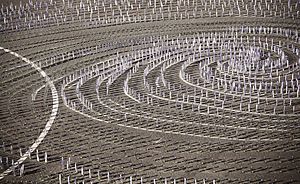Conceptual art facts for kids
Conceptual art is a type of art where the idea or concept behind the artwork is much more important than how it looks or what materials are used. It's like the artist wants you to think about a concept, not just admire a beautiful painting or sculpture.
What is Conceptual Art?
Sometimes, these artworks are called installations. An installation might be a collection of objects or a setup in a space. The cool thing is, anyone could put together some conceptual art just by following the artist's written instructions!
One famous idea about conceptual art is that "the idea becomes a machine that makes the art." This means the artist plans everything carefully beforehand. The actual making of the art is just following those plans. The main goal is to make you think about the idea.
Conceptual art even asks big questions like, "What exactly is art?" Artists like Joseph Kosuth helped define this new way of thinking about art.
How Conceptual Art Changed Art
Before conceptual art, many people thought art was mostly about creating beautiful objects. But in the 1960s, conceptual artists started to challenge this idea. They began to explore art using mostly language and ideas.
They questioned the old belief that an artist's main job was to make special physical objects. Instead, they focused on the thoughts and messages behind the work.
Today, the term "conceptual art" often refers to any contemporary art that doesn't use the traditional skills of painting and sculpture. It's more about the message and the thought process than the finished product.
Images for kids
-
Marcel Duchamp, Fountain, 1917. Photograph by Alfred Stieglitz
-
Art & Language, Art-Language Vol.3 Nr.1, 1974
-
An Oak Tree by Michael Craig-Martin. 1973
-
Robert Rauschenberg, Portrait of Iris Clert 1961
-
Barbara Kruger installation detail at Melbourne
See also
 In Spanish: Arte conceptual para niños
In Spanish: Arte conceptual para niños








